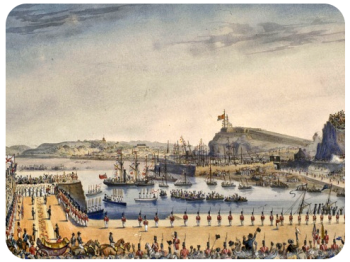Viscount in States
The year 1843 saw the final settlement of the dispute recorded in the previous chapter. A petition was sent up to the English Parliament by the Deputy-Viscount, conjointly with the law officers of the Crown for the time being, that the so-called ancient right of the Viscount to address the States might be enforced, and resulted in a reply from the Queen to the effect that Her Majesty, whilst not desiring in any way to interfere with the right of the Viscount (or Avocat du Roi) to be present at the meeting of the States, at the same time defined the duty of the former to be "in some degree analogous to the Sergeant-at-Arms in the House of Commons," and such being the case, his chief duties were "to levy fines for non-attendance at the meetings thereof".
Of other important items in the same year only two come prominently to the fore — the terrible storm which passed over Jersey, when the spire of St Peter's Parish Church was struck down (13 January); and the holding for the first time of the Summer Races on Gorey Common in the month of July.
Another storm
1844, except for the terrible storm that passed over the Island in July, when the Laura, a cutter, was wrecked in Grouville Bay on Conchier's Rock, in a WNW squall, and when fourteen lives were lost, was not otherwise remarkable except for the extension of the architectural improvements that took place, more especially in connection with the widening out of Mulcaster Street and Church Street — during which operations a portion of the old parish burial ground was done away with; the opening of St Mark's Church, and the building in each parish of regimental arsenals according to ideas approved of by General Don. At the same time, the year 1845 will always be an important one to Jersey as being the year in which the South-Western Company first began to carry the Royal Mails, and also of melancholy note, inasmuch as that in the August of that year the potato disease made its first appearance.
Coming to 1846, after much discussion it was decided by an Order in Council, dated 6 July, that the pier now known as the Albert Pier, should be erected at a cost not exceeding £110,000, to effect which desirable object it was decided that the Assembly of Governor, Bailiff and Jurats should annually vote £4,500 until one year after the termination of the work; an extra duty on wines and spirits being imposed for the purpose.
Rapid growth
And it is most interesting to find that at this period the maritime commerce of the Island, which aforetime had been only progressing by somewhat slow stages, increased with remarkable rapidity. During the years, for instance, when the St Helier harbour works were in progress, only 296 vessels, in all amounting to a tonnage of 27,075, belonged to the Island. In 1846 the returns showed 381 vessels, with a tonnage of 36,404, and employing 3,057 men to navigate them.
During the year 1846, too, the loyal feelings of the inhabitants of Jersey were more than usually aroused by a visit to them of Her Majesty Queen Victoria. Royal visits to the Island were, and still have proved to be, of rare occurrence, and it would seem that each and everyone at that time caused it to be their chief duty to make Queen Victoria's first visit to this, the last of the dominions of the Duchy of Normandy, one to be remembered, the last Royal visit prior to this having been when Charles II had come over as an exile.
Ladies wore white
Her Majesty was received on landing by the Lieut-Governor, Major-General Gibbs, the members of the Royal Court and of the States of Jersey, with all the pomp and ceremony due to the august arrival, a number of the most noted ladies of the Island, appropriately attired in white being present on the occasion, and in assembly uniting to sing the National Anthem. The whole of the Insular Militia were under arms, and lined the principal thoroughfares of St Helier, the main streets of which were decorated with triumphal arches.
Appropriate addresses were presented to Her Royal Majesty by the States, the Colonels of the Militia, and the officers of the parish of St Helier. But more than all, to commemorate the occasion it was decided to erect a College — for the purpose so long before proposed — of affording education for the rising male generations. This project, primarily suggested by Sir George de Carteret, and for which a patent had been granted by Charles II, however, actually took a substantial form in the following year. Meanwhile, the Albert Pier had been built, the Hospital Chapel in Gloucester Street erected, and once again, a Royal Commission had been issued for the purpose of inquiring into the criminal laws of the Island.
